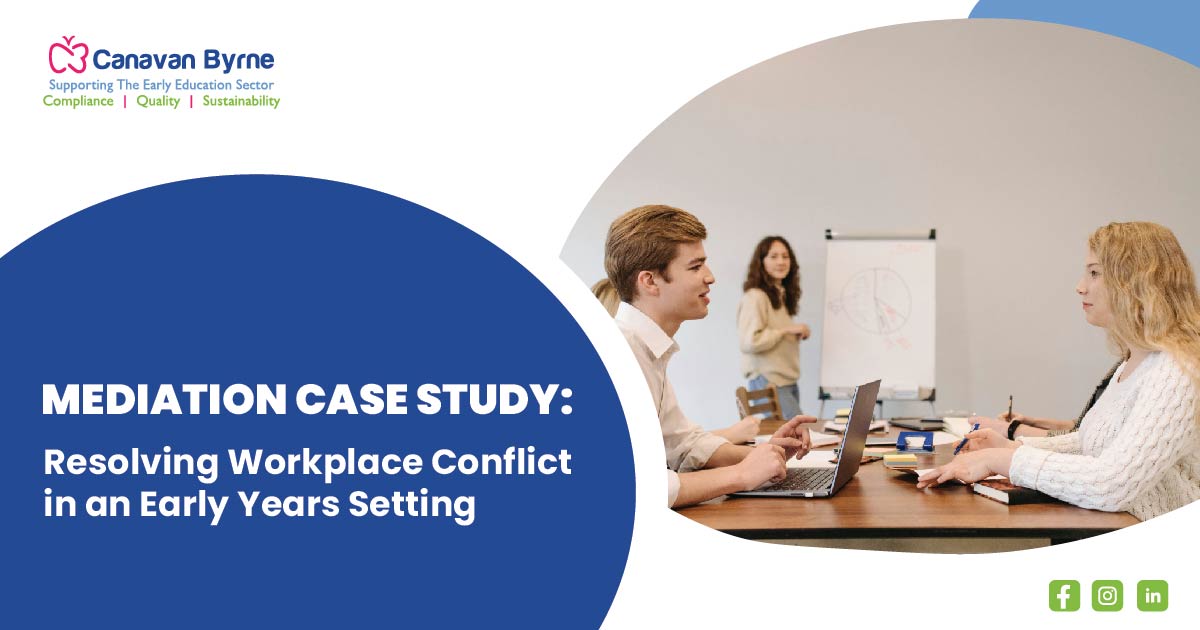
Background:
An Early Years setting in rural Ireland. The setting is a well-established early years setting with a team of dedicated professionals. Recently, tensions have arisen between two employees, leading to a formal grievance being submitted.
An Early Years setting in rural Ireland. The setting is a well-established early years setting with a team of dedicated professionals. Recently, tensions have arisen between two employees, leading to a formal grievance being submitted.
- Staff Member A (Supervisor - Emma): Emma has been working at the setting for five years and was promoted to Supervisor last year. She is highly experienced and passionate about maintaining high standards in the setting.
- Staff Member B (Early Years Educator - Sarah): Sarah has been with the setting for two years. She is committed to her role but feels increasingly uncomfortable in her working relationship with Emma.
Nature of the Grievance
Sarah has formally raised a grievance against Emma, stating that she feels belittled and unfairly criticised in front of colleagues and parents. She believes that Emma is constantly scrutinising her work, making negative remarks about her performance, and undermining her confidence. This has led to increased stress and anxiety for Sarah, affecting her overall job satisfaction.
Emma, on the other hand, asserts that her feedback is intended to be constructive and is aimed at ensuring high-quality care and education for the children. She feels that Sarah is overly sensitive to constructive criticism and perceives her guidance as personal attacks rather than professional development.
Both employees have agreed to participate in mediation to address their differences and find a mutually acceptable resolution.
The Mediation Process
Step 1: Pre-Mediation Meetings
The mediator meets separately with both Emma and Sarah to gain insight into their perspectives. During these meetings:
Step 1: Pre-Mediation Meetings
The mediator meets separately with both Emma and Sarah to gain insight into their perspectives. During these meetings:
- Sarah expresses her frustration, explaining that she feels micromanaged and undervalued.
- Emma shares her concerns that Sarah is resistant to feedback and does not always follow procedures correctly.
- Both employees acknowledge a willingness to resolve their issues but feel unheard by the other party.
Step 2: Joint Mediation Session
The mediator brings both parties together in a neutral setting. Ground rules are established, including:
The mediator brings both parties together in a neutral setting. Ground rules are established, including:
- Speaking respectfully
- Listening without interruption
- Focusing on resolving the issue rather than assigning blame
During the discussion:
- Sarah explains how Emma’s manner of communication makes her feel disrespected and anxious.
- Emma acknowledges that her approach may be perceived as overly critical and expresses a willingness to adjust her communication style.
- The mediator encourages both parties to explore alternative ways of providing and receiving feedback.
Step 3: Identifying Common Goals
Both employees agree on the following:
Both employees agree on the following:
- They both want a positive and professional working relationship.
- They share a commitment to providing the best care for the children.
- They are willing to adapt their communication styles to establish a better work environment.
Step 4: Agreement & Action Plan
With the mediator’s guidance, the following agreement is reached:
- Emma will provide feedback in a constructive and private manner where possible.
- Sarah will be open to receiving feedback and seek clarification if she feels unclear about expectations.
- A bi-weekly check-in will be established to discuss any concerns in a structured and non-confrontational manner.
- If either party feels issues are arising again, they will seek support from management before tensions escalate.
Outcome
Following mediation, both Emma and Sarah report an improvement in their professional relationship. Sarah feels more comfortable seeking feedback, and Emma has adjusted her approach to ensure that her guidance is perceived as supportive rather than critical. The structured check-ins help both parties to address concerns early, preventing future conflicts.
Conclusion
This mediation case highlights the importance of effective communication in workplace relationships. By developing mutual understanding and setting clear expectations, conflicts can be resolved in a way that benefits both employees and the overall working environment.
Canavan Byrne provide a mediation service. If if you wish to avail of this service, contact Aimee Groves at: aimee@canavanbyrne.ie
Share this article



